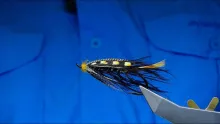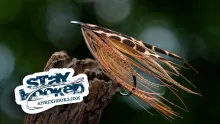Like many fly tyers, I've always had a fascination with spey style flies.
Updated or edited 9 months ago
Like many fly tyers, I've always had a fascination with spey style flies. Whether the slender classic dressings with their tented bronze mallard wings, or the bright featherwings of Syd Glasso, spey and spey style flies seem to bring out the best in fly tyers.
When I learned that Bob Veverka was coming out with a book on spey flies, I was thrilled. I have admired Bob's tying for quite some time - as I always considered him one of those rare tyers of salmon and spey flies whose flies are museum quality beautiful, yet they have the sleekness and symmetry of a well tied fishing fly. I was not at all surprised to learn that such notables as Poul Jorgensen, Bill Hunter, and Syd Glasso had a major influence on Bob's tying career, as they all share that same trait. All of them tie exquisite flies, crafted with seasoned eye of a life long fisherman.
While the title might lead one to believe this is a how-to instruction book, you'll have to read about 90 pages before you put thread to hook. Up to that point, the book is split between two outstanding chapters - one on the history of spey and spey style flies, and one on materials used on these and other similar flies. In fact, the portion of the book that is instructional, as far as the subtitle "how to tie them" is concerned, is quite minor. The introductory chapters represent over half the book page volume, and only three of the subsequent chapters on fly styles feature step-by-step instructions.
The chapter on materials, in particular, is outstanding. At first blush, you might wonder how much there is to talk about, since most of the classic spey flies had only a few ingredients, but Bob recognizes his reading audience will likely also have an interest in salmon flies as well as spey and similar flies. Given this, and the fact that some of the patterns shown in the book blur the boundary between spey fly and salmon fly, Bob gives us a dissertation on materials that can be used in both disciplines. A veritable brain dump of his knowledge on materials - which will be fascinating for any tying junkie to read.
The rest of the book is separated into chapters devoted to specific styles of flies - Spey, Dee, River Don, Eagle, and miscellaneous spey type and steelhead spey flies. I thought it a little odd that the River Don and Eagle chapters lacked photos. In a book packed with stunning color photos, surely a couple more wouldn't have broken the publisher's budget. There are photos of Eagles in the introductory chapter - why not in the chapter on Eagle flies? A minor nit pick, to be sure.
I should mention the photos in the book are the works of the well known Michael Radencich. In addition to the excellent step-by-step instructional series, the book is also liberally sprinkled with eye candy, either photos of flies or feathers. In fact, the chapter on the history of spey flies has altenating full page color photos of flies that will be sure to please.
In was pleasantly surprised to see that Bob includes flies from so many other tyers, both masters such as Syd Glasso as well as contemporaries such as Brad Burden and Rick Whorwood. You couldn't find better examples to use to inspire your own tying.
It's hard to imagine that a book subtitled "How to Tie Them" features only three step-by-step tying sequences, but I can't think of much that has been omitted. I'm still unsure how the golden pheasant body feathers form the wings on Syd Glasso's Sol Duc Dark, but I guess such a minor thing does not warrant special treatment. Spey flies, and their close cousins, are in their essence sparse flies with slender bodies, long flowing hackles, and slim sleek wings. Even the somewhat gaudy Dee flies share these characteristics. As such, if you learn to tie one spey flies, you're well on your way to knowing how to tie them all - the chief difference being different winging materials and techniques. I guess that is what prompted Bob's choice of teaching flies, and why he limited the actual instructional material in his book. If you can tie the bronze mallard wing of a spey fly, the slip wings of a Dee fly, and the hackle wings of a Glasso style spey fly, you pretty much can tie any of these patterns.
This is a book many people have been waiting years to see. They won't be disappointed.
- Log in to post comments







